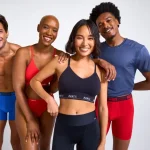Shares of Foot Locker Inc. fell $11.73, or 16.7 percent, to $58.72, on Friday after the sneaker giant reported first-quarter results that came in below Wall Street estimates and predicted comps would show a modest gain in the second quarter due to continued sluggish sales.
In the quarter, earnings slid 5.8 percent to $180 million, or $1.36 per share, a penny short of Wall Street’s consensus estimate of $1.38.
“Let me start by saying we’re certainly not satisfied with our results this quarter, even though it was still a highly profitable quarter — one of our company’s best ever despite the unprecedented challenges we experienced early in the quarter,” said Dick Johnson, chairman and CEO, on a conference call with analysts. “Our goal is to continually raise the earnings bar higher, and we did not quite succeed in achieving that in the first quarter.”
On April 20, Foot Locker warned that it expects earnings in the first quarter ending April 29 to come in between $1.36 to $1.39 per share. Wall Street’s consensus estimate at the time had been $1.47 a share.
Foot Locker blamed the shortfall on delayed tax refunds that prevented U.S. consumers from spending earlier in the year. A number of other brands in the active-lifestyle space, including Hibbett Sports, Finish Line, Shoe Carnival, DSW, Caleres and Genesco, as well as broader players such as Wal-Mart have likewise pointed to the drag on traffic.
On Friday’s conference call, Johnson noted that February has historically been one of the biggest months of the year for the company and comps were down low teens. Particularly hurting sales was the delay in refunds until after the NBA All-Star Game, a major footwear launch event. March rebounded up high-single digits. April then showed a “very high single digit increase” although the company had expected April to finish up low-double digits. Said Johnson, “The last couple of weeks of the quarter were strong, but not quite as strong as we anticipated. This caused us to produce earnings of a $1.36 per share at the low-end of our revised outlook.”
In the current quarter so far, he added that sales were “trending a bit lower than we had planned over the last few weeks.” As a result, the company is now forecasting second-quarter comps to be up low-single digits, with earnings relatively flat compared to a year ago.
Johnson further indicated that the company plans to implement cost-measure should sales remain sluggish.
“While we remain optimistic that we can accelerate our momentum over the second half of 2017 to reach mid-single-digit comparable sales gains, we are developing a Plan B, so to speak, in case recent sales trends continue,” he said. “That Plan B is primarily focused on controlling expenses and inventory so that we can deliver the mid-single-digit EPS increase for the full year, excluding the 53rd week that we mentioned in our pre-announcement, even if top line growth is more modest than what we originally planned.”
Johnson added that while he believes the each of the company’s banners are “positioned at the center of a very vibrant sneaker culture,” one newer challenge Foot Locker is facing is that trends are changing faster than ever.
“Young people today are digital native,” said Johnson. “They change their shopping and buying habits quickly, they adopt and discard social media platforms in a heartbeat. The people who influence their preferences can change rapidly. And as a result of all of this, they see and adapt new athletic footwear and apparel styles more quickly than ever.”
In the first quarter, net sales inched up 0.7 percent, to $2 billion. The Street’s consensus estimate was $2.02 billion. Excluding the effect of foreign currency fluctuations, total sales for the first quarter increased 1.8 percent.
First-quarter comps increased 0.5 percent. In its updated guidance on April 20, Foot Locker said it expected comps to increase at a low-single digit percentage rate. At the time, Wall Street on average was expecting a 2.7 percent same-store increase.
By segment, direct-to-consumer jumped 12.1 percent on a same-store basis while its stores posted a 1.2 percent comp decline. Within direct-to-customer, sales at its storebanners.com business in the U.S. were up high-single digits while its digital operations in Europe and Canada were both up strong double-digit.
Eastbay, still its single largest digital banner, was up low-single digit, “a solid improvement from its performance over the past year,” said Lauren Peters, EVP and CFO. Overall, direct-to-customer expanded to 13.9 percent of total sales from 12.7 percent a year ago.
In its store segment, Champs and Foot Locker Canada continue their strong sales results each delivering mid single-digit comp increases, driven by gains in both footwear and apparel. Foot Locker U.S., Footaction and Foot Locker Asia-Pacific posted low single-digit comp declines while sales at Kids Foot Locker were down in the mid teens.
Among product categories, footwear was close to flat, apparel increased mid-single digits and accessories posted in mid-single digit decline.
Women’s footwear posted a comp sales gain just shy of double-digit, men’s footwear were up low single-digit and children’s footwear declined mid-single digit. Continued strong demand was seen for lifestyle silhouettes, led to the mid-teens gain in running. Casual footwear was down mid-single digit, while basketball was down mid-single digit due in part to the delays of IRS tax refund mailings until after the NBA All Star game. Average selling prices in footwear were up mid-single digit, reflecting continued demand for premium merchandise while units were down mid-single digit.
The strength in apparel was relatively broad based, with gains across most of its geographies, channels and genders. Men’s and children’s apparel were both up mid-single digit, while women’s apparel posted a double-digit gain. Average selling prices in apparel were up double-digits, while units were down reflecting the company’s ongoing shift to a more premium assortment.
The company’s gross margin rate decreased to 34 percent of sales from 35 percent a year ago. The lower rate reflects a 40 basis points decline in its merchandize margin rate and a 60 basis points of deleverage on its occupancy and buyers compensation expenses. The lower merchandise rate was primarily as a result of higher markdowns at its direct-to-customer business, where the company was more promotional than in the past in order to drive traffic and clear slower moving products. At its stores, the markdown rate continued to improve despite the softer top-line growth with the gains attributed to its premium-focus strategy.
SG&A expenses increased 30 basis points to 18.5 percent of sales due to the lower-than-planned sales combined with a minimum wage increases and higher medical benefit costs.
At April 29, inventories were $1.28 billion, 1.5 percent higher than at the end of the first quarter last year. Using constant currencies, inventory increased 2.8 percent.
On the call, Johnson elaborated on the progress the company is making on its key growth initiatives: driving performance in its core business, expanding its leading position in kids, pursuing European expansion opportunities, improving apparel, building a powerful digital business, and recapturing growth in women’s.
Regarding its core mall banners, Foot Locker North America, Champs Sports and Footaction, Johnson noted that while U.S. store traffic was down in the quarter, the drop was entirely driven by February due to the tax refund delays. Said Johnson, “Traffic in the remainder of the quarter improved and we expect traffic, which has been positive most of last year, to normalize over the balance of the year.”
Johnson said its banners, including Foot Locker Australia, “continued to operate at a very high level of productivity” in the quarter and its positioning is being helped by a “successful remodel program” as well as the addition of high-profile stores this year in Toronto, Chicago, Los Angeles, Sydney and Melbourne. A new point-of-sale system will arrive later this year to further improve the customer experience.
Kids was hurt in the quarter in part because vendors aren’t making “some of today’s most popular styles in kid sizes” in addition to the “still soft signature business” that had been a key driver of kids in recent years. For the rest of the year, kids is reducing its exposure to signature product and lifestyle product quantities are expected to improve. Thirty-three new Kids Foot Locker stores are expected to open this year, including 20 in North America and 13 overseas, to support growth.
In Europe, comp sales were down low-single digits in the quarter, but total store sales were up slightly given the addition of 26 net new locations compared to a year ago.
“Given recent macro events in Europe, traffic there was uneven across our major markets and down in the quarter overall,” said Johnson. “We consistently find that our customers in Europe are quite resilient and so we believe the traffic there will gradually rebound.”
High-profile stores are set to open in Rome and Turkey last this year. At its Germany-based Runners Point and Sidestep stores, comps were down mid-single digits but that marked improvement over its recent performance. The digital business continues to “grow rapidly” across Europe.
Apparel saw sales grow at a faster rate than footwear in the first quarter and continued to improve its margins. Champs Sports, which has the highest apparel penetration among its banners, continued to perform well and has benefited from a good response to private-label offerings. Another highlight was Kids Foot Locker, where apparel sales posted a high single-digit comp gain with improved margins. Overall, additional apparel printing capabilities is helping the company respond to design trends more quickly in private label.
The momentum in direct-to-consumer is expected to be helped by the rollout of an order management system, which is being tested at one of its smallest online banners. Said Johnson, “This new platform is expected to significantly enhance our online conversions by increasing page load speed, improving product displays and suggested add-on purchases, optimizing video content and connecting ever more seamlessly with our other customer.”
Foot Locker is also focusing on increasing buy-online, in-store pickup. Said Johnson, “While we will always want to satisfy a customer by being able to ship them the product they want from wherever in our system it resides, an even better scenario for us is to have them come to a store to pick up their merchandize, where we can then engage with them, augment their experience with our brands and potentially add to their original purchase.”
In women’s, SIX:02 continued its recent strength and was the only store banner to post a double-digit comparable sales gain. With the two relatively new non-comp flagship stores in New York City, total sales at SIX:02 were up more than 50 percent. Another SIX:02 flagship is set to open in Los Angeles is Q4. The banner’s most-productive store is the six02.com and “even stronger merchandising” is expected to boost online sales for the banner for the rest of the year.
At its other banners, women’s continues to see “steady growth,” aided by an intensified focus on the” female muses” at each banner as well as “compelling product stories and assortments” from Nike, Adidas and Puma.
Across footwear categories, Johnson expects product flow will strengthen in the second quarter and build as back to school approaches.
“VaporMax is a perfect example of really great innovative new program from Nike,” said Johnson. “After a small introduction in Q1, the number of SKUs in units we’ll have available will increase significantly during the current quarter and in the back half of the year. Similarly we’ll have some of the Adi product with Boost material notably Nomads and Ultraboost. It’s the combination of all of these great products and strategic initiatives that gives us confidence that we can drive gradually improving top-line and bottom-line performance over the balance of the year.”
Photo courtesy Foot Locker
















